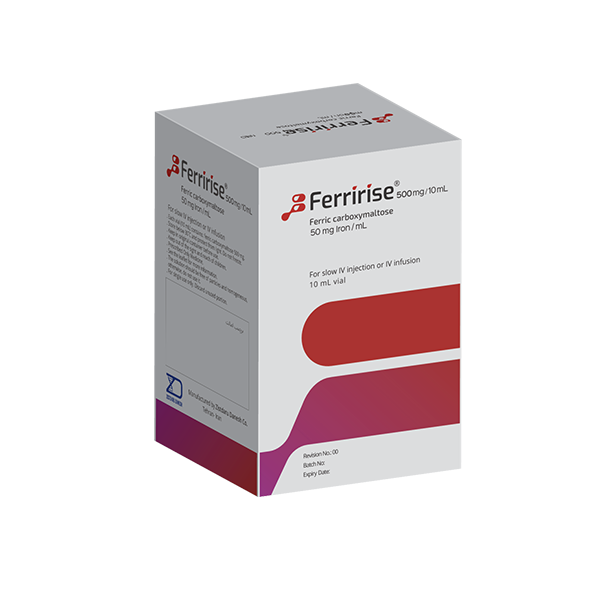1. What is Ferririse®?
Ferririse® contains the active pharmaceutical ingredient ferric carboxymaltose used in the treatment of iron deficiency anemia in adults.
2. Mechanism of action
Ferric carboxymaltose is a carbohydrate polymer in the form of colloidal ferric hydroxide combined with carboxymaltose to deliver iron.
3. Indications
Ferririse® is a substitute for iron used in the treatment of iron deficiency anemia as follows:
●Patients intolerant of oral iron or with inadequate response to oral iron.
●Patients with chronic kidney disease (CKD) and not on dialysis.
4. Dosage and administration
-Inspect vials of Ferririse® for particles and no change in color before use. The solution should be free of particles and homogeneous, otherwise, do not use it.
-The vial is for single use only. Discard unused portion.
-The solution should be used immediately after opening.
-The dosage is prescribed by the doctor, but the usual dose of the drug is as follows:
• In patients more than 50 kilograms of weight:
The recommended dose is given in two doses of 750 milligrams injected intravenously at least seven days apart to be 1500 milligrams in total. It may also be given 15 milligrams per kilograms (at most 1000 milligrams) in a single dose.
• In patients less than 50 kilograms of weight:
The recommended dose is 15 milligrams per kilograms in two doses injected intravenously at least seven days apart.
*Ferririse® can be slowly injected intravenously (undiluted) and/or be injected by intravenous infusion.
-Slow intravenous injection: injection should be at 100 milligrams (equivalent of 2 milliliter) per minute.
-Intravenous infusion: dilute at most 750 milligrams of iron (equivalent of 15 ml of Ferririse) with at most 250 ml of sterile sodium chloride 0.9% solution for injection (sterile normal saline solution for injection), so that the iron concentration be 2 to 4 milligrams per milliliter and the iron concentration not lower than 2 milligrams per milliliter and then be intravenously infused for at least fifteen minutes.
Avoid extravasation of Ferririse since brown discoloration of the extravasation site may be long-lasting. Monitor for extravasation (Leaking out of the veins and into the surrounding tissue cause tissue damage through blistering and ulceration). If extravasation occurs, discontinue the administration at that site.
* In case of anemia recurrence, treatment courses may be repeated at the doctor’s discretion.
5.Dosage form
Ferririse® is available in the single-dose vials of 10 milliliters injectable solution containing ferric 500 milligrams (50 milligrams ferric per milliliter) undiluted for slow intravenous injection and/or intravenous infusion.
6.Warnings and Precautions
●Hypersensitivity reactions:
There are reports of hypersensitivity reactions including anaphylaxis that in some cases may be life-threatening or fatal. These reactions may be along with clinical symptoms such as shock, bradycardia and loss of consciousness. To this effect, patients should be monitored for hypersensitivity reactions up to half an hour after the injection.
●Symptomatic hypophosphatemia:
-There are reports of symptomatic hypophosphatemia (decreased levels of phosphate in blood) in need of clinical interference in users of ferric carboxymaltose susceptible of decreased phosphate levels. These reactions are reported more in patients receiving injections of ferric carboxymaltose several times.
-Patients with gastrointestinal disorders such as problem with absorption of fat soluble vitamins and phosphate, hyperparathyroidism, vitamin D3 deficiency, feeding difficulty and concurrent use of ferric carboxymaltose with drugs affecting kidney function may be more susceptible for hypophosphatemia. In the most cases, hypophosphatemia resolves within three months.
-Monitoring blood phosphate levels especially in susceptible patients during frequent treatment courses with ferric carboxymaltose is recommended.
●Hypertension:
There are reports of increased blood pressure in the users of ferric carboxymaltose. Increased systolic blood pressure may lead to hot flashes, dizziness or nausea in such patients. This increased blood pressure usually occurs immediately after the injection and resolves within 30 minutes.
●Changes in laboratory test results:
Serum iron and transferrin-bound iron levels may be higher than normal in medical diagnostic tests up to 24 hours after the injection of ferric carboxymaltose.
7.Adverse reactions:
•Very common (more than 10 percent of patient population)
-Endocrine and metabolic: decreased serum levels of phosphate
•Common (1 to 10 percent of patient population)
-Cardiovascular: hypertension, hot flashes
-CNS: dizziness, headache.
-Dermatology: skin color changes in injection site.
-Endocrine and metabolic: decreased phosphate.
-Gastrointestinal: nausea, vomiting, constipation, taste loss.
-Hepatic: increased levels of liver aminotransferase (AST) enzyme
8. Ferririse® drug interactions
-Since ferric carboxymaltose can interact with other drugs, make sure to tell your doctor of the list of drugs you take before starting it.
-Concurrent use of Ferririse® with oral iron supplements may decrease the absorption of oral iron. To this effect, take oral iron supplements at least five days after Ferririse® injection.
9.Use in Specific Populations:
• Pregnancy
-Currently there are not enough studies made to assess the safety and efficacy of ferric carboxymaltose in pregnant women. Using injectable iron may lead to hypersensitivity reactions including fetal bradycardia. On the other hand, not treating iron deficiency anemia in pregnant mothers may be risky. Using ferric carboxymaltose in pregnancy is at the physician’s discretion.
-In case you are pregnant or plan to become pregnant, consult your doctor before taking this medication.
• Lactation
Studies indicate that ferric carboxymaltose is secreted in mother milk. Using ferric carboxymaltose while nursing is at the doctor’s discretion.
• Children and adolescents
Safety and efficacy of this drug in children under 18 has not still been proved.
• Elderly
Studies made with patients over 65 indicate that safety and efficacy of ferric carboxymaltose in the elderly is not any different from others. However, more sensitivity in this age group should be considered.
10. Drug overdose
-In case of a drug overdose, contact the poison control center or healthcare providers so that necessary measures to alleviate symptoms may be taken.
-The overdose of ferric carboxymaltose may lead to iron accumulation in the body. Symptoms of intoxication improve after the injections are discontinued.
11.Storage
-Store below 30˚C and protect from light. Do not freeze.
-Keep in original container before use.
-Keep out of the sight and reach of children.
Prescribed Only Medicine.


